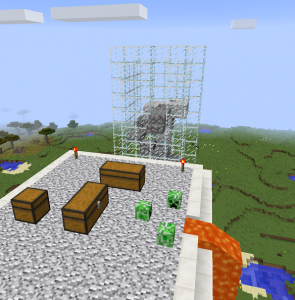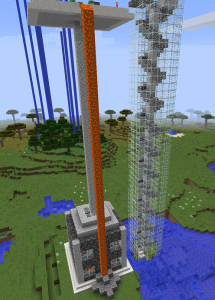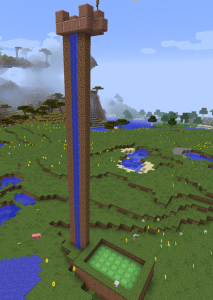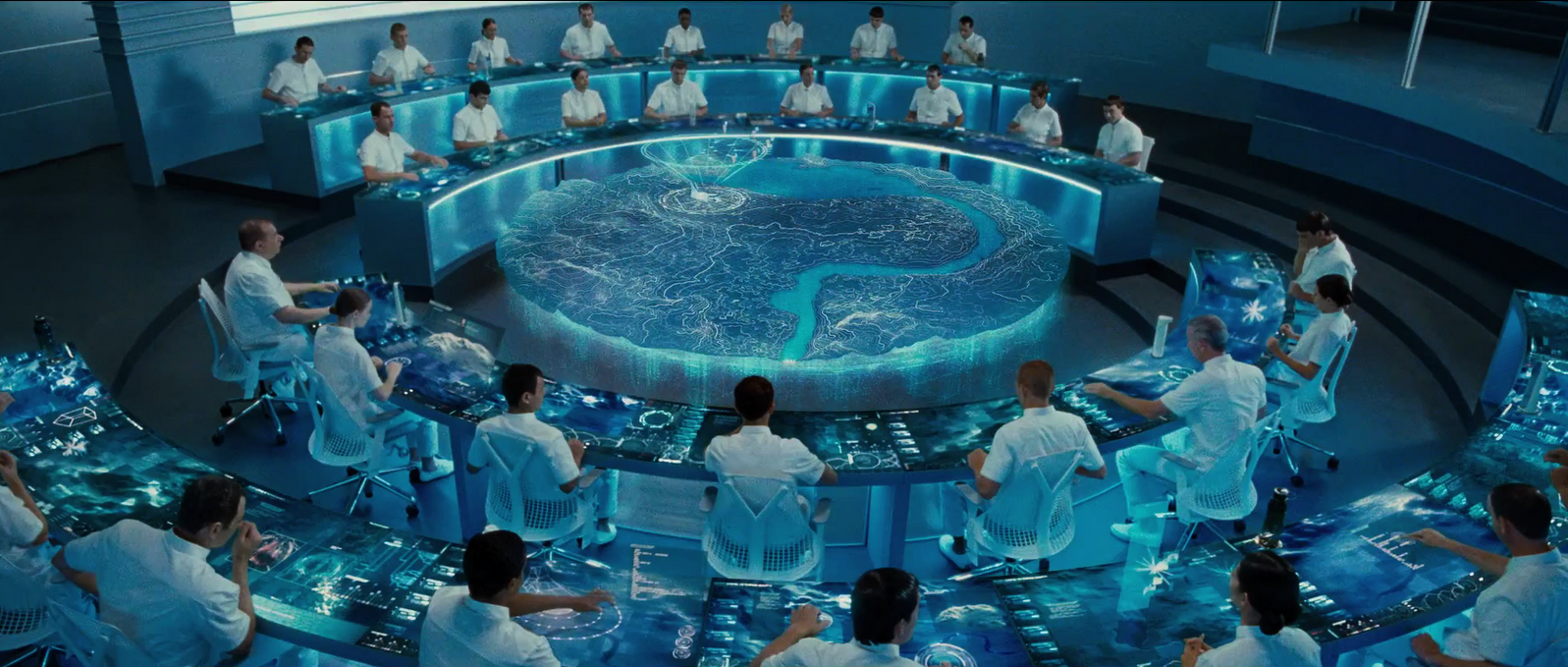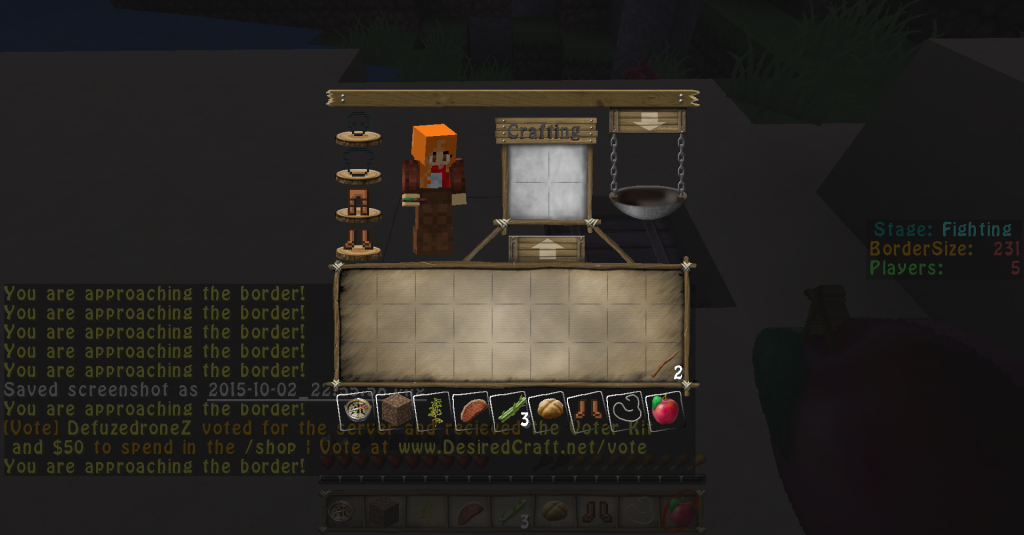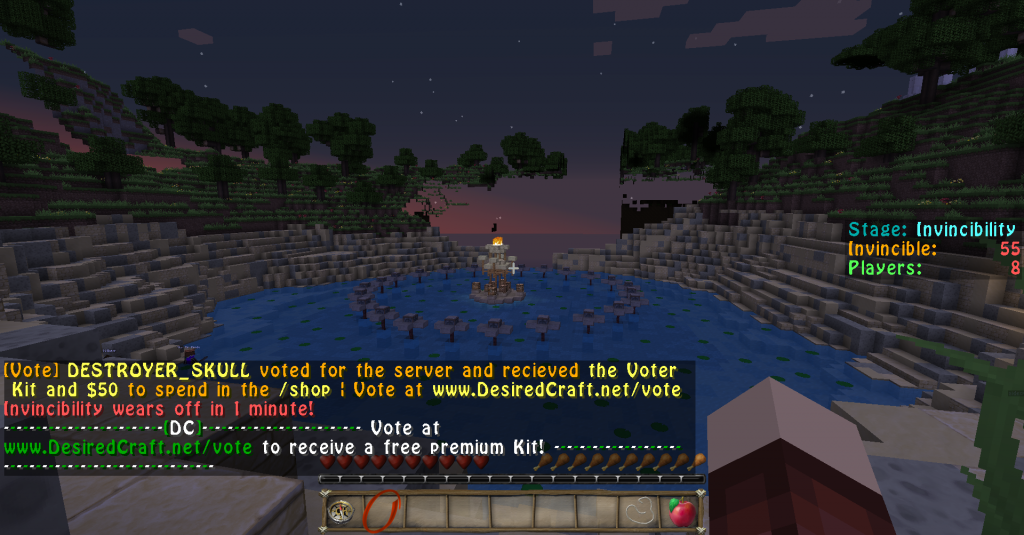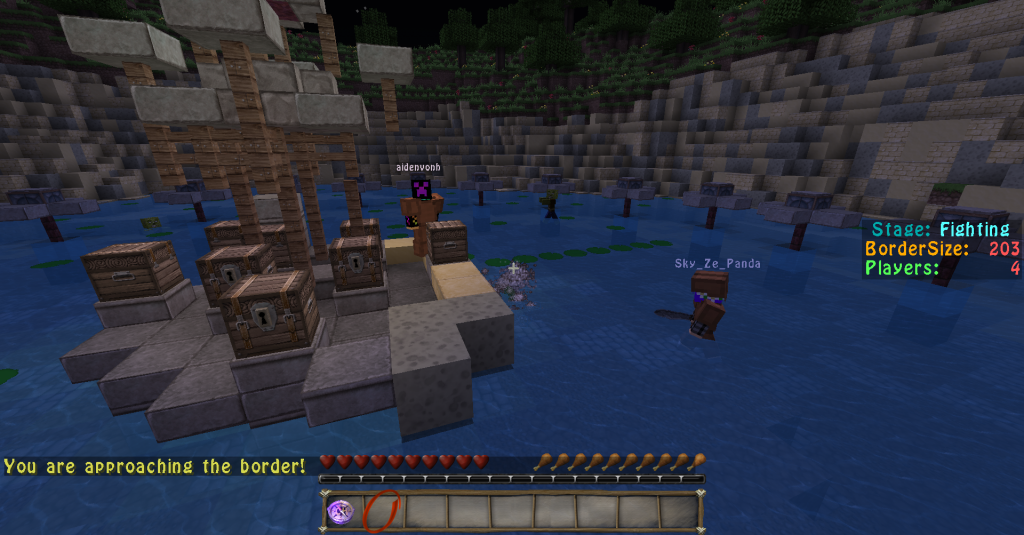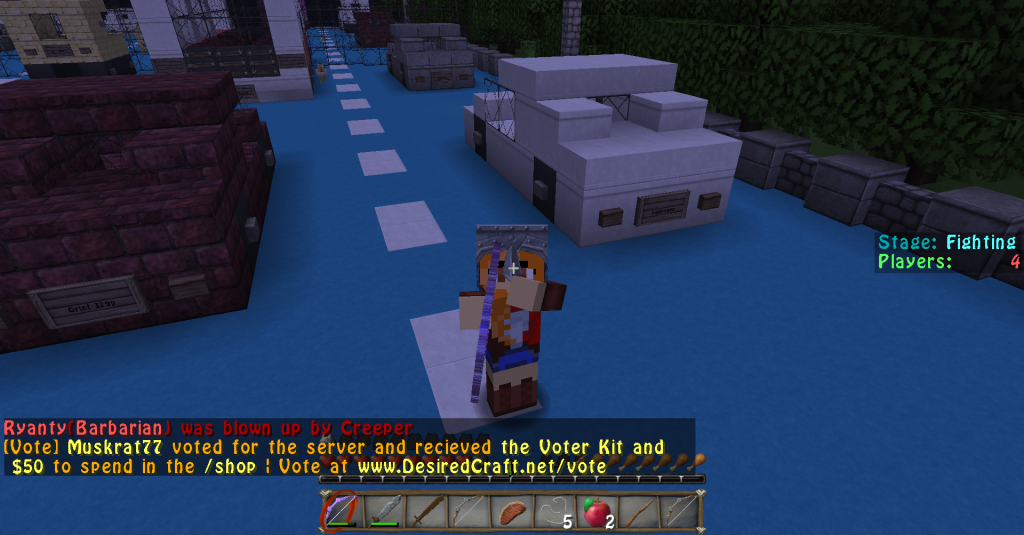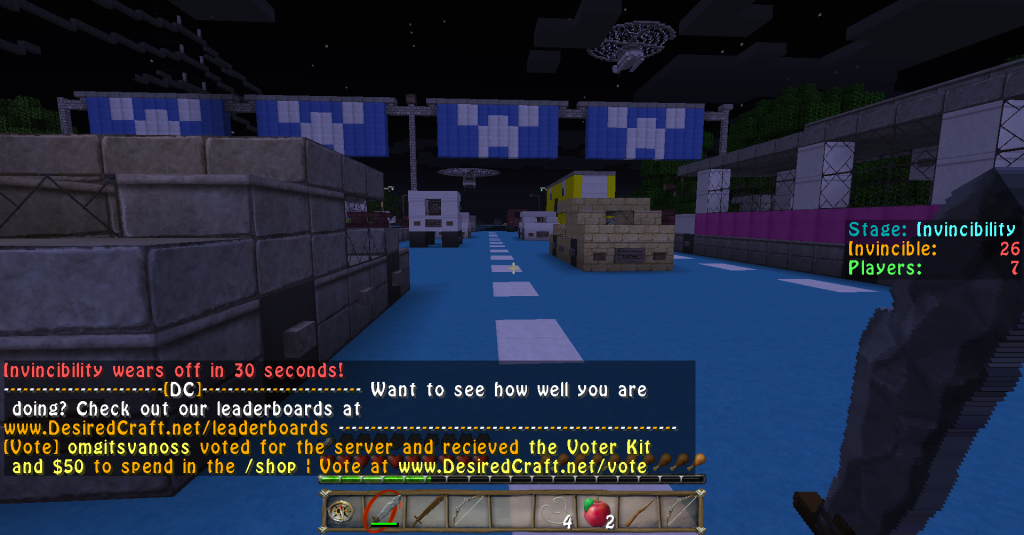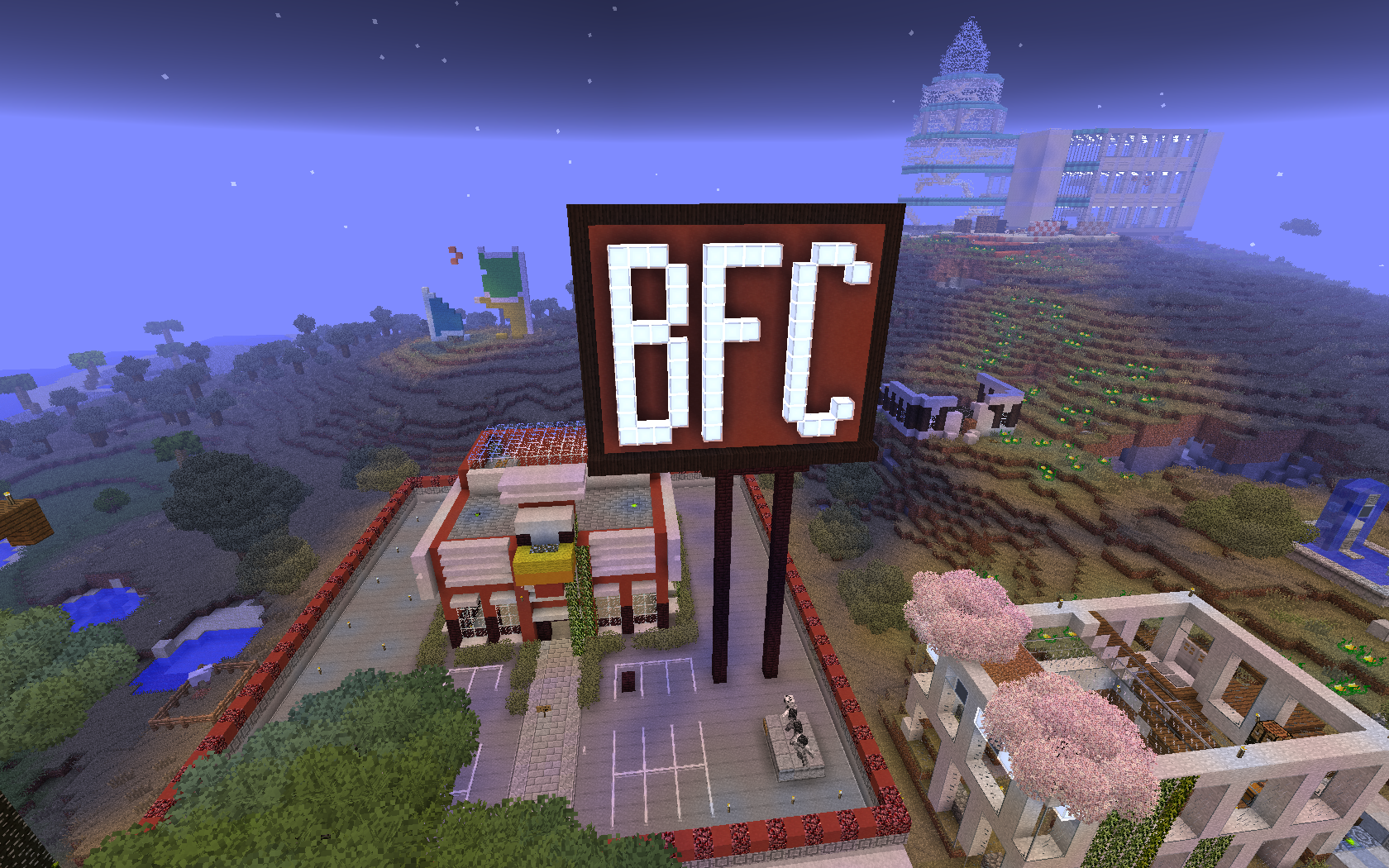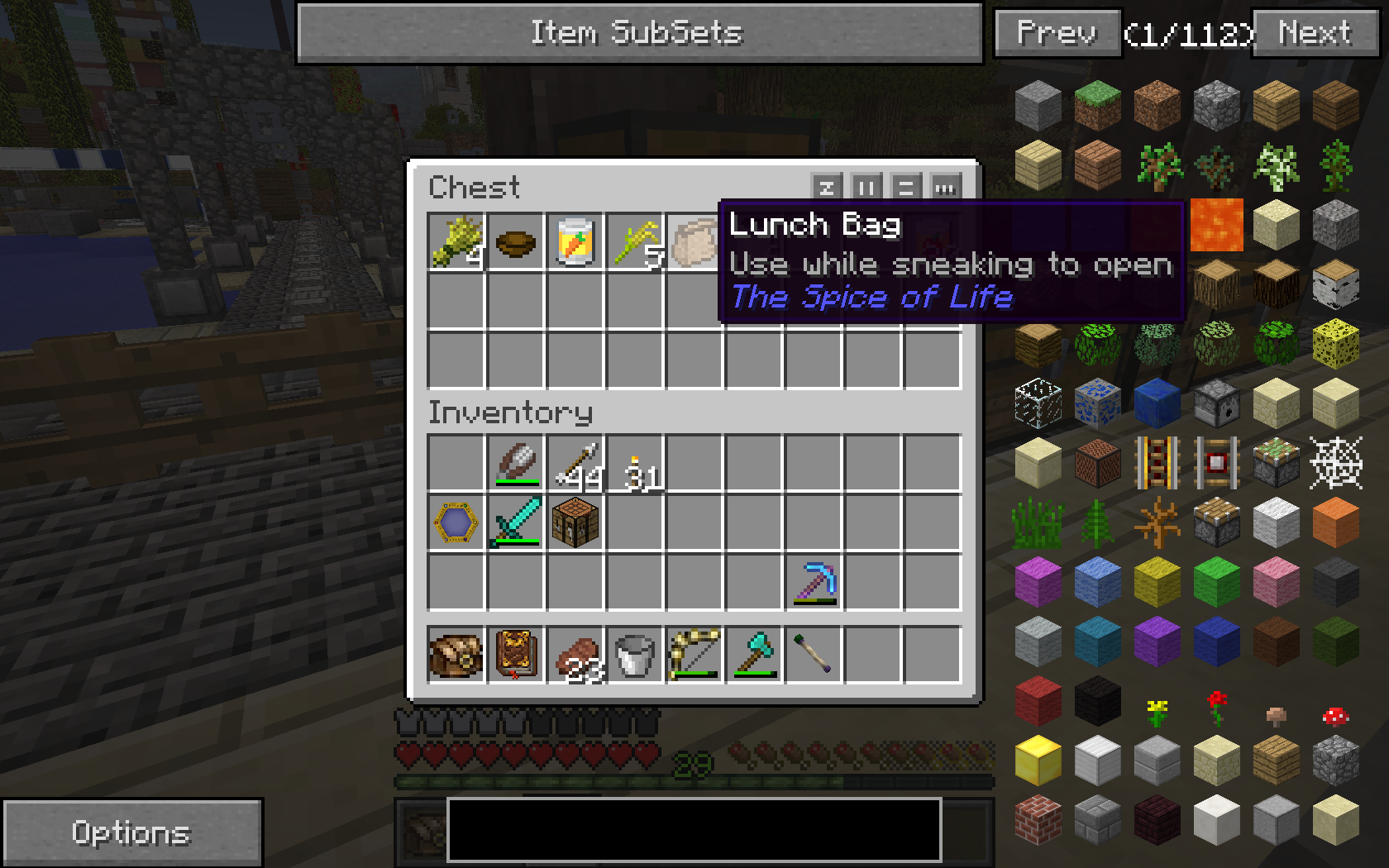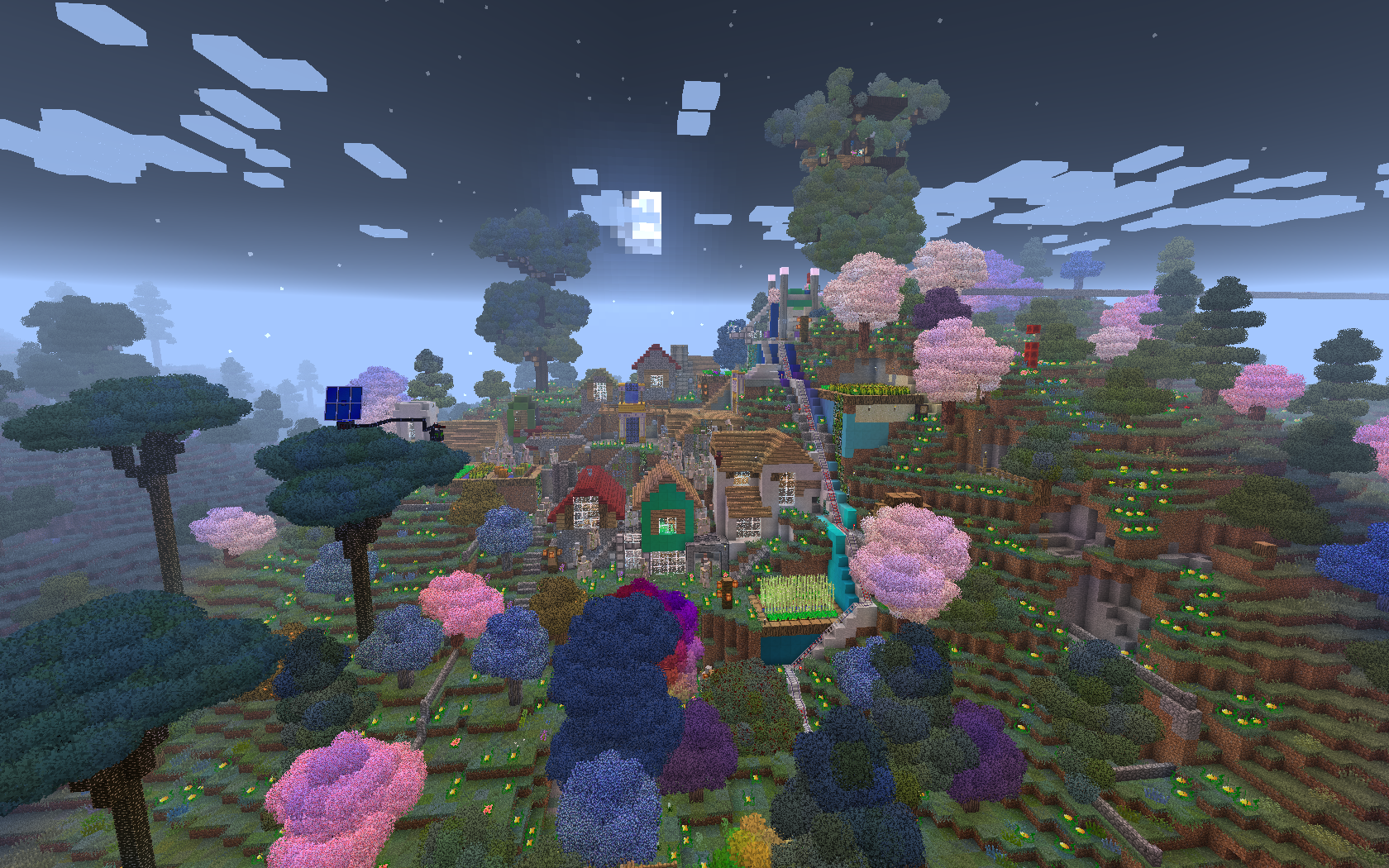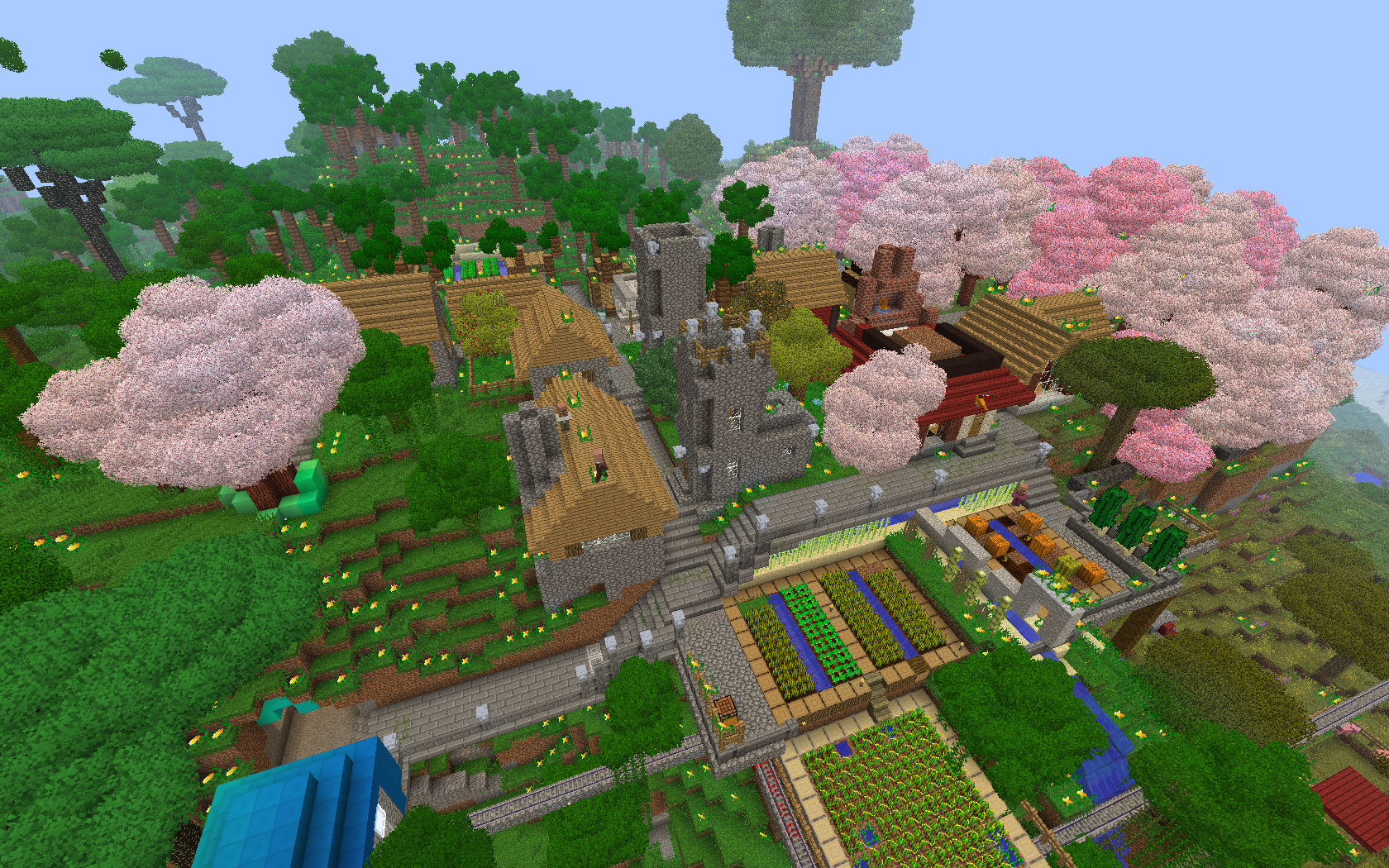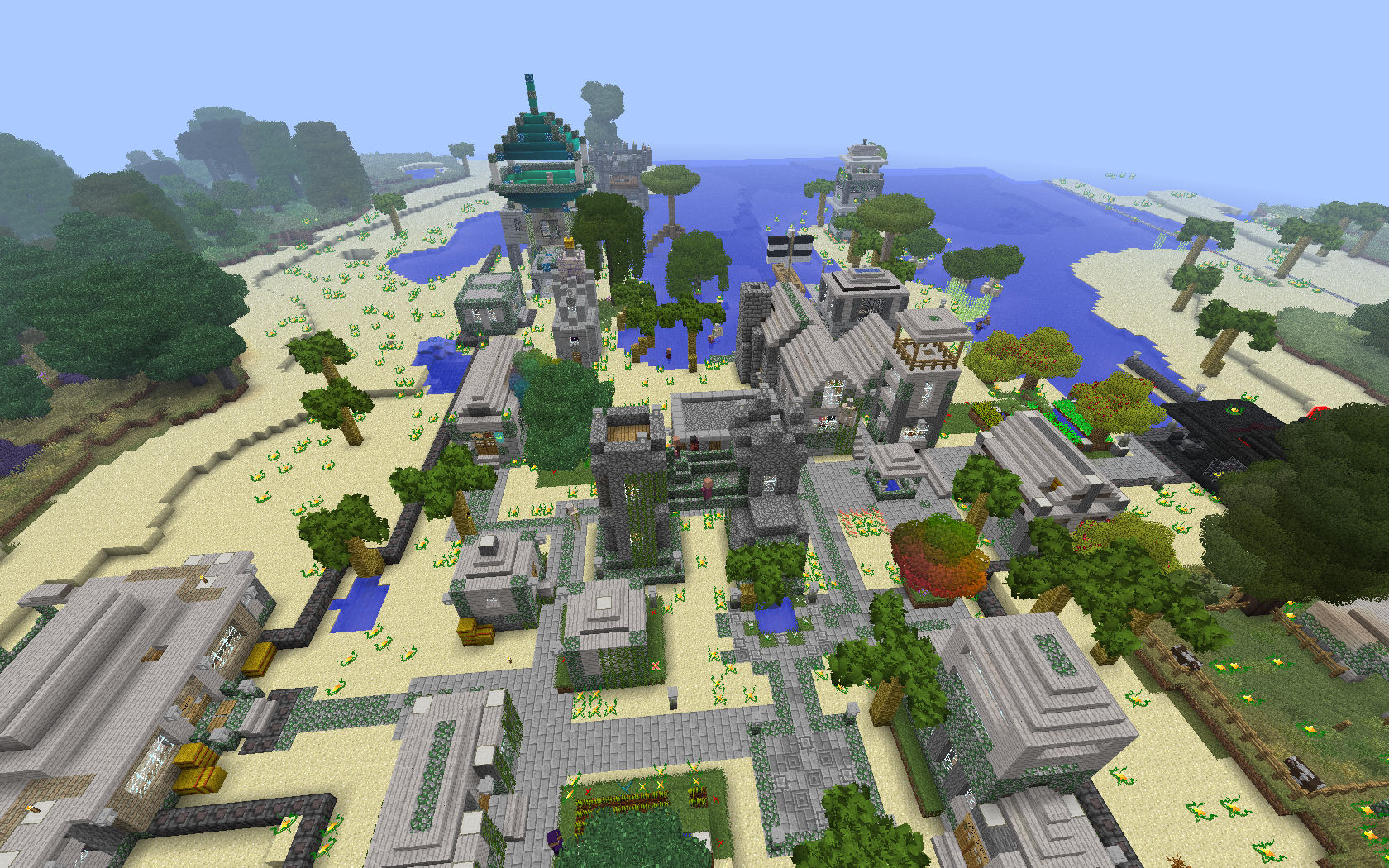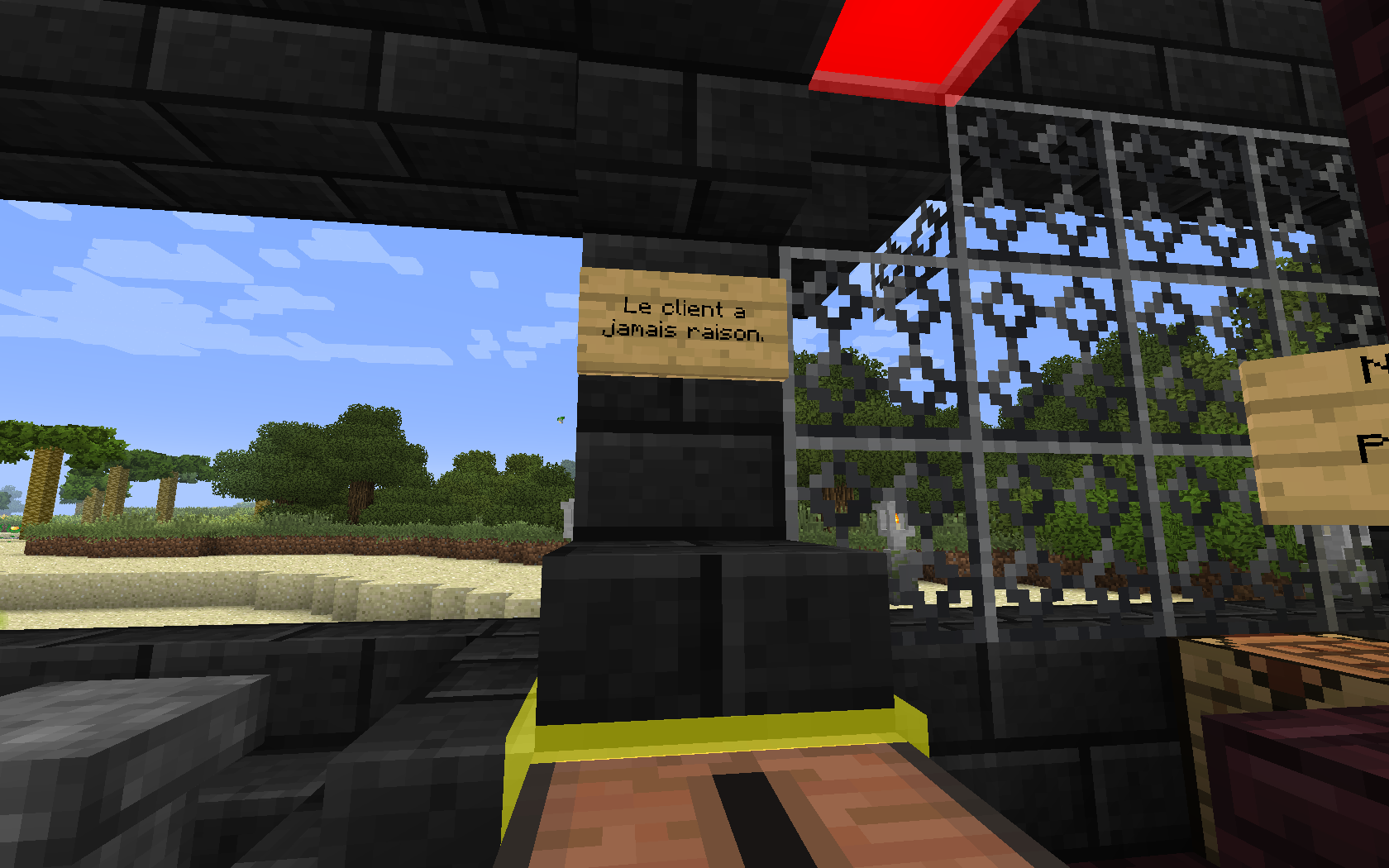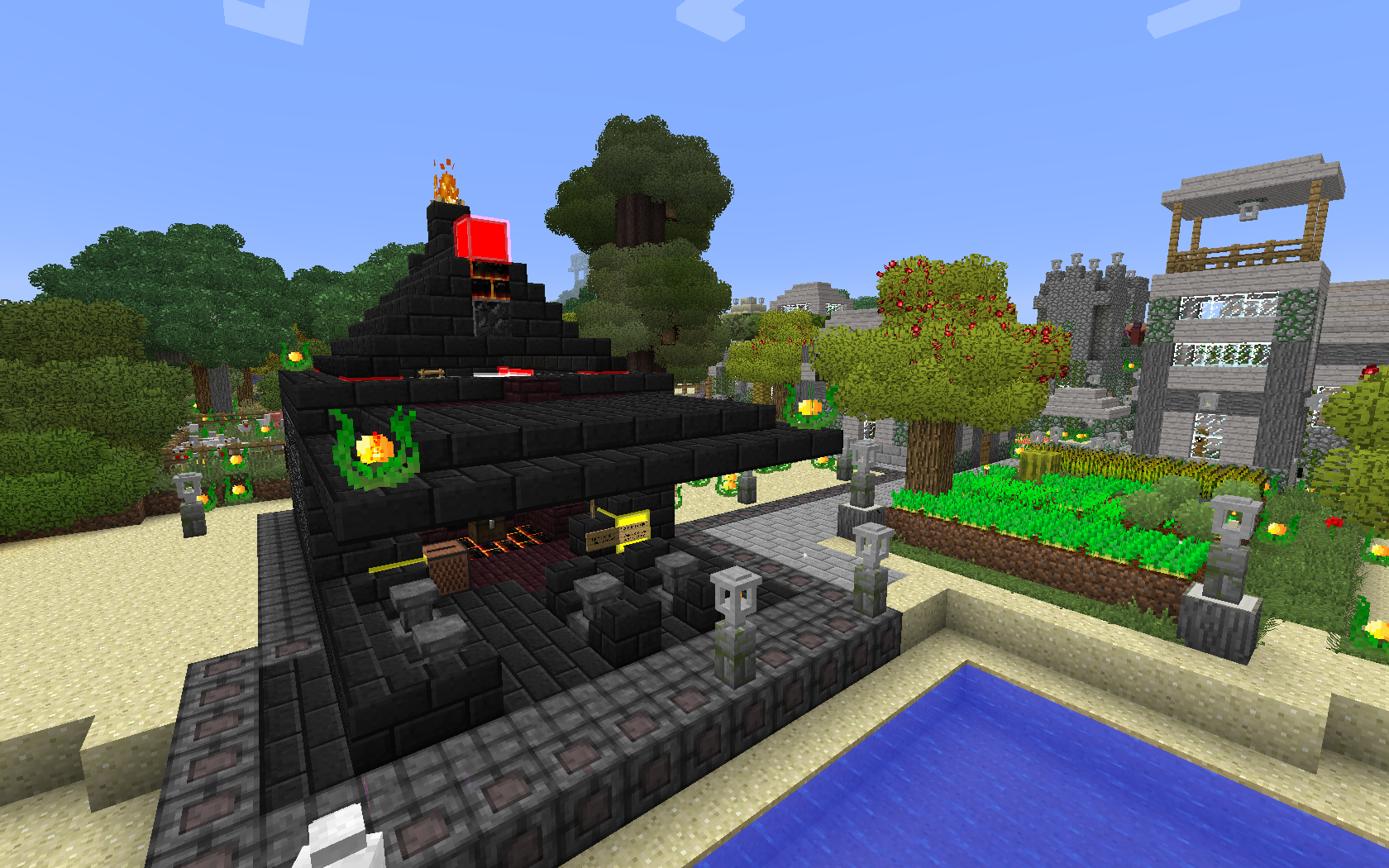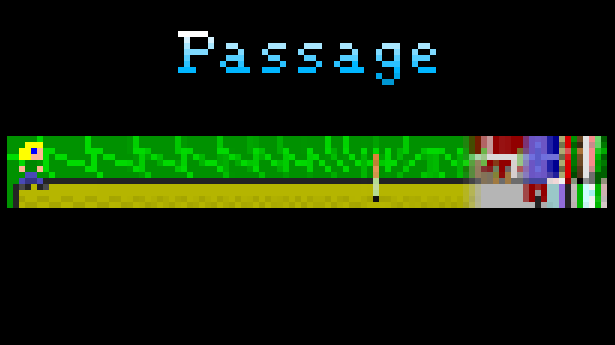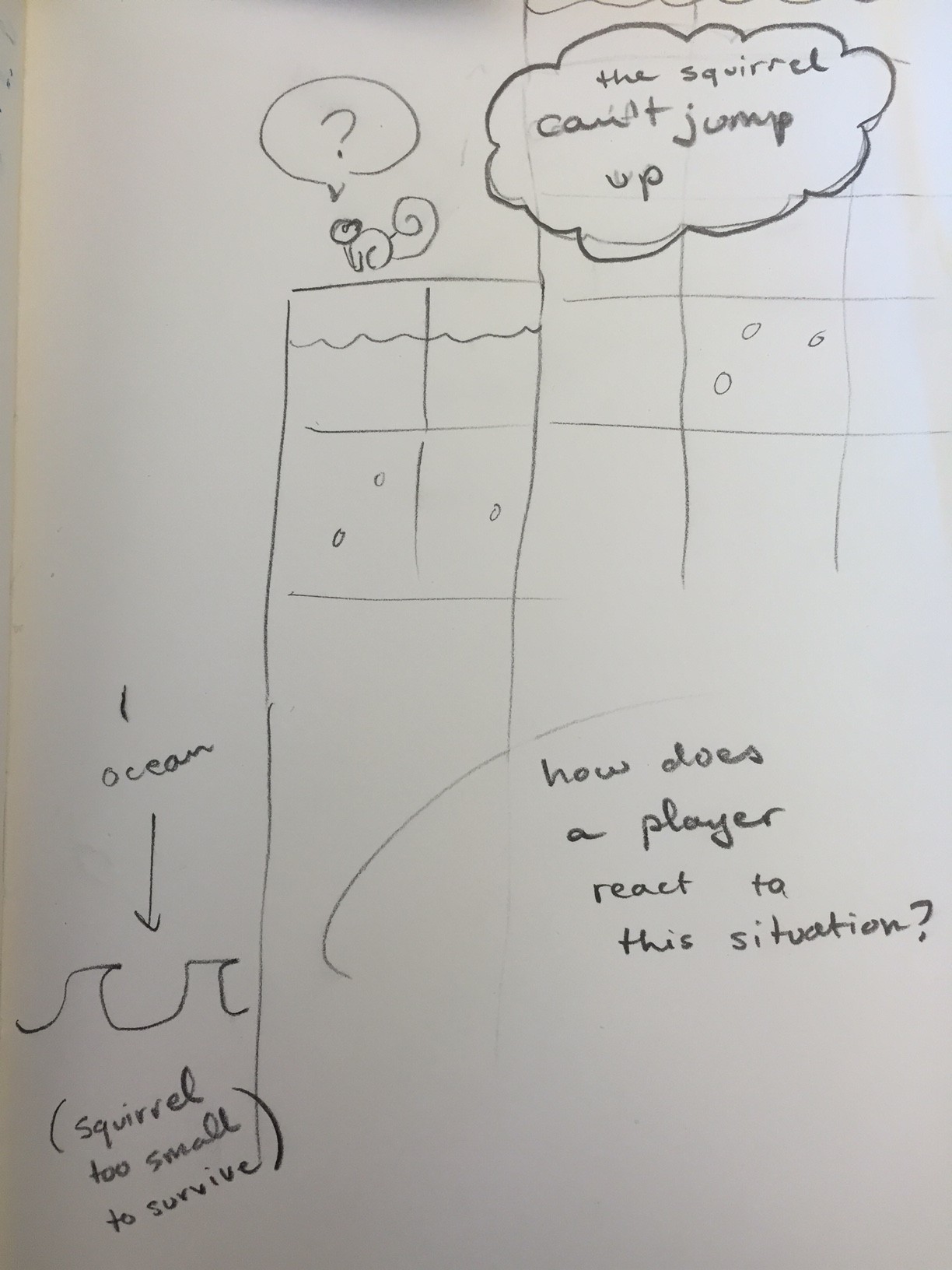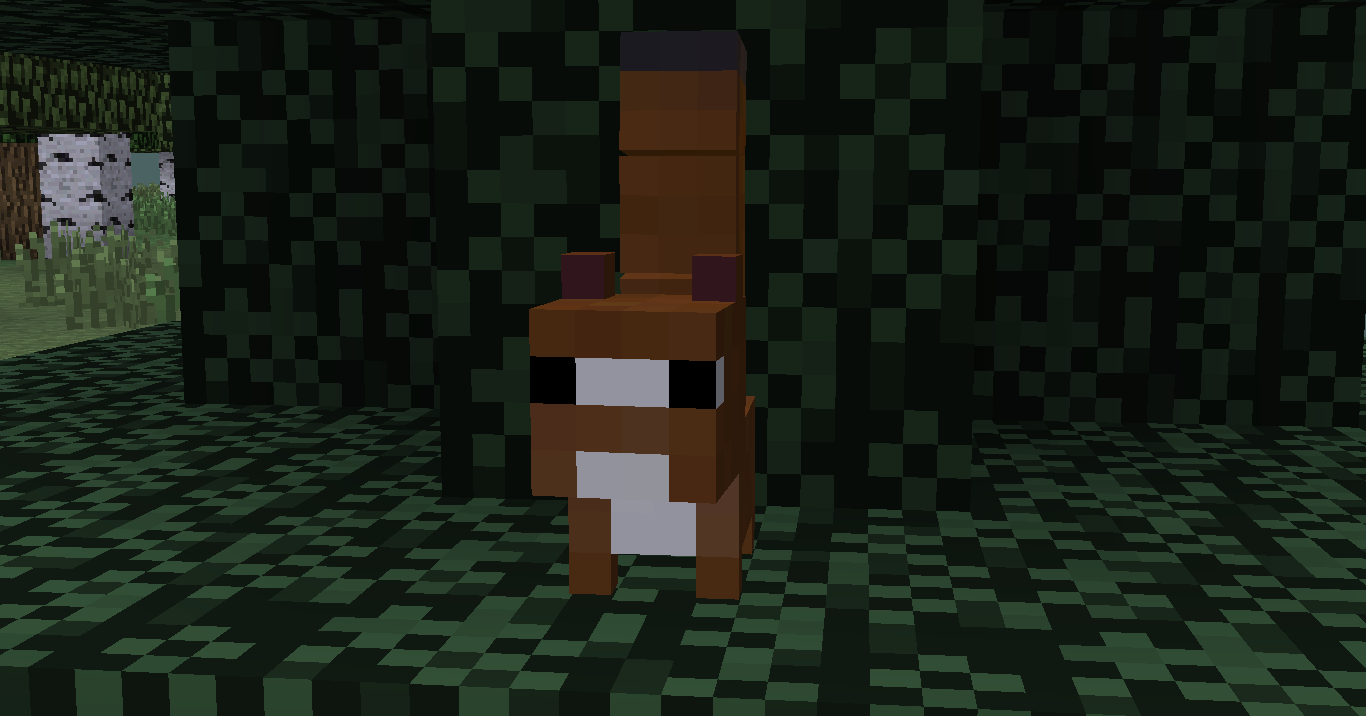The post Hunger Game Design 1 appeared first on &.
]]>For our first design, Saeed and I choose to create an elevated cornucopia with twelve towers. Participants would “spawn” in one of the twelve towers and would have the option of jumping onto the lower cornucopia platform, with chests and the possibility of death, or run down the spiraling staircase and into the ocean. From there, they can swim towards land surrounding the cornucopia.
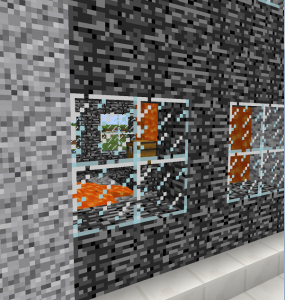
windows that allow the player to see the large chest therein when they descent using the spiral staircases
The basics of the idea are as follows:
The cornucopia and spawn points are located in the middle of the map and each corner of the map would feature a different zone such as a volcano zone and a forest zone. The cornucopia sits on top of a chamber whose door is hidden by a downfall of lava. The player needs to secure a bucket and water (found in a chest on the cornucopia platform), throw it onto the lava, make their way down to ground level and then will be able to enter the chamber and take possession of the prestigious prize. We don’t expect players to understand this puzzle right away and have thus added windows that allow the player to see the large chest therein when they descent using the spiral staircases. We understand that once the puzzle is understood, the game might become dull if played repeatedly, but at the same time, Hunger Game maps in the novels are only used once; the tributes do not know what is going to happen, or what surprises they may find. Hence, we may want to introduce a system that would not allow a player to enter a match again after 2 or 3 deaths.
The player map area is completely surrounded by glass (this will be called level 1). The player can only play within the confines of level 1 terrain. The game makers, i.e. us, have access to levers and events on the top of this terrain, henceforth named level two. Players do not have access to the second level. This allows us to view and control events going down on the map. We can spawn monsters from above and into the play area to motivate activity like in the films and books. We found that creatures could survive elevated drops except for spiders that died on impact. We tried spawning them on top of water, but the spiders still died. Finally Saeed created a slime trampoline that allowed us to spawn spiders without them dying on impact.
We can also set forests on fire to force players closer together through slots on the second level. We practiced with lava and trees grown in close proximity and found that we could control forest fires. Unfortunately, lava falls very slowly. We would need to figure out a way to set the forest on fire more quickly. Additionally, we found that we built out platforms too high, making the spiraling staircases overly long. We would need to build our platforms less high. We also found that creating an ocean in Minecraft is much harder than it looks. At the moment, our ocean looks like a right mess – we would need to spend more time studying how oceans are generated in the game.
The group meeting allowed us to view our peer’s map proposals. We found that our map may be to limiting for players in terms of re-playability. However, we do not necessarily see this as something wrong, as, like I previously stated, this would work hand and hand with the “real” Hunger Game mechanics: learn quickly, stay sharp, and don’t die, or you cannot come back. We still have a long way to go in terms of map creation and in terms of what aspects of Hunger Games we want to explore. Do we want to explore player-map interactions? Do we want to simulate a more accurate depiction of Hunger Game? How do we want to differentiate ourselves from other PVP #hungergames servers? In what ways will our maps create a relationship or dialogue with the novel’s narratives (if at all)? In the weeks to come I hope we are able to sit down together and discuss the future of our project in relation to these questions.
The post Hunger Game Design 1 appeared first on &.
]]>The post Place for a “real” Hunger Games server? appeared first on &.
]]>This week I plan to share my ideas for how to create a more authentic portrayal of the novel “Hunger Games” in Minecraft.
What seems to be the crucial element in the realization of a “Hunger Games” server is the player-versus-player arena. Why do I say this is crucial? Every #Hungergames servers we have tried has revolved around players fighting other players in order to survive and “win”. However, that appears to be the only thing that is like “Hunger Games”. I believe this is boring and is just an excuse to call everything #Hungergames when in fact, it is only PVP. So what could WE do differently?
For starters, we could have our own “Head Gamemaker”. What, or who is this person? In the book it is Seneca Crane, and then Plutarch Heavensbee. As “Head Gamemaker” they create the arena where the participants from the different districts will compete. Once the games begin, they control the environment with their team of controllers that can cause forests to combust instantaneously, creatures to magically appear or any other such activity. By doing these things, the Gamemaker insures that the different “tributes” will end up close to each other and thus fight – creating a “glorious show” for the residences of the Capital (or a depressing and distressing one for the districts watching their children die).
So what could we do? We are all technically “Gamemakers” in that we will be creating the arena. My suggestion is that we have live events. Of course, we could not always hold live events as we do have lives other scholarly things to do–but the idea remains that we could host events. First, we would need to make sure that all “gamemakers” are in some sort of “creative mode” and perhaps invisible to players in “survival” mode. Second, we would create a sort of ceiling around our map — this ceiling would be made out of glass. We could see everything happening on the field from our high vantage point. Third, we would have levers or other devices we could switch on and off to: pour lava from the sky and burn the forest, release mobs, et etc. This would allow us to create a more realistic Hunger Game competition like in the “Hunger Game” novel. Additionally, each event a different member could rule as “Head Gamemaker” and make the crucial decisions.
But why should we only focus on this one aspect of the novel?
While speaking with Nic on this subject, I told him about one another though I had come up with and that we then expanded together.
The bigger Minecraft servers usually have multiple “lobbies” to hold many players: players might be in these lobbies to mingle, to choose a game, or are waiting for a game to end so that they may start. Why not have our lobbies named after the 12 districts?
When a player would log into our server they would be assigned to a district. From there they wait for their turn to be selected by the computer. When it is their turn, the chat would post a message, example:
Marie has been selected to represent district ____
At this point, another player could then respond with something like:
//I volunteer as tribute! OR //VAT
of course, then Marie would have the choice to begin her game or to allow the other player to volunteer.
Alright, so players can play around in different lobbies while they wait for the game to start, big whoop, what else?
Well, some players could also be placed within The Capital and be given thousands of diamonds. These players could then play as invisible players within the actual arena and dispense presents to their favorite tributes–like in the novel. The “tributes” would be teleported to a room where they could talk with the players in the Capital lobby and barter for help.
We could also give players access to different things depending on their lobby; swords, bows, fire, wood, etc.
Perhaps we could have a point system and once a player has won enough credits they can “pay” to be moved to the capital.
Another idea was that any player who actually died in the arena would die in the game: they would no longer be able to fight in the arena — perhaps they could be “reborn” as members of the capital? Able to visualize the events and help players out or spring traps, but essentially invisible within the arena. Or perhaps we could give each player 5 lives to play within the arena and then they are “dead” ?
These ideas had us asking new questions: would these new rules really create a true depiction of Hunger Games? would players actually feel the class distinction and the terror at losing? Would a war break out between the districts like in the film? Would the capital want to quealm it? What would we have to give players in The Capital to have them maintain other players and keep ruling? How many players would jump the boundaries or play and begin acting as security? What kind of game would this become? Would we moderate it or just allow player to rule it as they wished? Would we even have enough players for this to happen?
I am unsure. While this might create a more realistic portrayal of the books, it seems like a lot of time and energy. Perhaps all players want is to kill other players without consequences. To know that if they die they can play the game again. Perhaps they don’t care that the game is not really Hunger Games but just a small aspect of the book, or even just a ploy to entice more players into PVP servers. This idea would require a lot of cooperation to build, and then a lot of players to fill. We might want to look at servers such as Potterworld (http://www.potterworldmc.com/), a “Harry Potter” Minecraft server that has a staff of over 100 unpaid players that take on the roles of prefects, professors, scripters etc. As well as the hundreds of players that play as muggles and students. This server is interesting in that players are essentially playing at being students at Hogwarts: they must attend classes, do homework and pass exams in order to pass each grade and then graduate. Once they graduate, they can apply to become professors, aurores, deatheaters, or any other Harry Potter role. The fans maintain and keep this server alive — it is their investment and interest in the franchise that allows this server to function as it was intended. Without the fans, the server would slowly disappear.
If we were to create a “real” Hunger Games map, including the different districts, the class inequality, et ect, could we achieve what Potterworld achieved? Or would chaos reign right away as players decided to attack the Capital right away? Would we even obtain enough players to make this work ?
Perhaps for now, it is but a dream. However, I do believe that we should start by creating a way to control events in the arena, become Gamemasters and thus create “live events”. What think you?
The post Place for a “real” Hunger Games server? appeared first on &.
]]>The post The #HungerGames Function appeared first on &.
]]>Hunger.
Games.
A game about survival for food. A game of high consequences. In 2008, Suzanne Collins released a book titled “Hunger Games” that followed a young adult female protagonist who volunteers to take her sister’s place in a mandatory death match enforced by “the capital”, the Elite society that controls the fictional world of Panem.
So what does it mean to transpose this narrative into a sandbox game such as Minecraft? Can it even be called “Hunger Games”?
The questions we must ask before we begin our construction of a quote-on-quote “Hunger Games” arena are as follows:
What is Hunger Games? What makes Hunger Games, Hunger Games? Is it the narrative, the characters, the atmosphere, the environments? Can we simply reduce it to a Player-versus-player all out death match? How can we recreate the true essence of “Hunger Games” within Minecraft—is it even possible?
I found that often the hashtag “Hunger Games” is included in conjunction with multiple others. This use of Tags lures Hunger Games fan into joining a server that promises them the “Hunger Games” experience. The use of “Hunger Games” encourages fans to flock to the server. Could these servers only be “survival” games which have existed for a long time but are now under the guise of “Hunger games” as a means to encourage more players to join?
Commenting on my ideas on “Hunger Games” as a hashtag, Nic Watson says;
“Interesting how some of the graphic banners on that list show a subset of tags that doesn’t include ‘Hunger Games’, but ‘Hunger Games’ is in the text tags. Like they want to make it show up in HG searches but not actually promise HG. Maybe we should look at what tags are collocated with HG tags. Perhaps that could go under ‘variants’”
The “Hunger Games” games are usually included with various other mini games on one server including various PVP arenas, and Sky Block.
These are example of PVP/Hunger Game-like servers found under the tag “hunger games”:
* Play.mc-lengends.com
* Mcsimplegaming.com
* Mc.hypixel.net
* http://www.ubermc.net/minecraft-the-walls/
However, this last server is a little different from the other PVP servers above and specifies team work in order to win:
“Minecraft The Walls is a very unique server type. 4 teams divided by a walls that keep peace for the first 15 minutes of the game. During this first 15 minutes all the players on each team are given a specific class that allows them to help their team in different ways. For instance the alchemist can create potions for their team for when the walls drop. or the blacksmith that can forge weapons and armor using their anvil. Below each team spawn there are mines to be explored and resources to be exploited. Team work is crucial to winning this game as each player has a unique role. The last team to survive after the walls drop, wins the game” (The Walls).
Names and titles take on a life of their own online, both explaining the context and enticing players. But what can we say about these games that may not really be “Hunger Games” portrayals, but just PVP games using the hashtag Hungergames?
These servers are mainly focusing on the battle arena, the all-out district war (The annual Hunger Game) while overlooking everything else about the novel. In this way, what makes them any different from PVP?
In my graduate class we read sections from Michel Foucault. “What is an Author?” brings up a valid argument and question about the way players are using the key words Hungergames.
Consider this: are we, and everyone else who tags their Minecraft server, using the “author function” as a way to gain credibility and legitimization? What are we promising when we assign the hashtag #Hungergames to our game servers?
Foucault explains that “such a name [the author’s name] permits one to group together a certain number of texts, define them, differentiate them from and contrast them to others […] establish a relationship among the texts” (227).
When talking about transmedia narratives, Game scholar Henry Jenkins explains that “Audience familiarity with this basic plot structure [read: knowledge of the narrative] allows script writers to skip over transitional or expository sequences, throwing us directly into the heart of the action” (Jenkins 120). While franchises create Transmedia narratives, Minecraft can work as a form of fan generated transmedia narrative that allows players to interact with aspects of the media they normally would not have access to. However, most of these #Hungergames servers reduce the narrative to a single moment: the arena battles—we are literally thrown into the “heart of the action”, however, are we trivializing the rest of the novel that looks into inequality, poverty, capitalism, et ect? Without a deeper understanding of the consequences (are there any consequences in an online game?) of the “Hunger Games” as portrayed in Collin’s book, can we actually be anything more than a PVP using a hashtag as a function to obtain and entice players?
What are we doing to Suzanne Collin’s “Hunger Games” novel by thus tagging these PVP servers? What can we do to create a more authentic server? Is it even possible to create a server worthy of the term “Hunger Games”?
In my next post I will look at a few ways we could construct our server with these questions in mind.
Work cited
Foucault, Michel. “What is an Author”.
Jenkins, Henry. “Convergence Culture : Where Old and New Media Collide”. New York: New York University Press, 2006.
The post The #HungerGames Function appeared first on &.
]]>The post When Arenas Attack appeared first on &.
]]>This week, I tried playing on a different server from my usual – you know, keeping things fresh, and all. My normal server plays like a pretty typical Hunger Games server; there’s a cornucopia, limited items, and implied instructions that you’re just supposed to kill everyone else who’s there.
This new server had all of the above, with a few added features. First, there’s a longer period of invincibility. Most Hunger Games servers give you a bit of this; it gives players a chance to go to the cornucopia and grab as much stuff as they can without being immediately killed. Yes, this is unlike the books or the movies, where the cornucopia is just a bloodbath from the start. On my usual server, however, the invincibility does not last for an incredibly long time. If you stop and camp near the middle of the playing field, other players will come, find you, and engage you in combat almost immediately.
On this new server, on the other hand, there was more time given – over 100 seconds. This doesn’t seem like long, but in Hunger Games time, this is an eternity. I wasn’t too sure why, at first – I grabbed what stuff I could from the chests in the middle, and started walking away, a bit more leisurely than usual. Nobody even tried engaging other people – it was just a mad dash for stuff before running away in different directions. I had so much time to get away and find a hiding spot, so it wasn’t a big deal if I wasn’t super prepared. Honestly, I was carrying almost nothing:
And then it started to get dark. Really dark.
This is where this server differs from other servers I’ve played on: almost as soon as the game starts, it gets dark. Dark, in the Minecraft world, means that monsters will appear. And while this is okay for a bit, due to the extended invincibility of this game, it very quickly turns into not okay. Monsters were everywhere, and with such limited supplies, I found it very difficult to survive. I really felt as if the arena was out to get me almost as soon as the game had started. There were a few chests around, but they were few and far between, and none contained anything I could really use to protect myself. So I ran.
This is different than most of the other servers I’ve played on, and it ties in with some of the ideas that we were throwing around at our last meeting. What would happen if the arena was more hostile towards the player? Would players react differently towards both the environment and to the other players? Certainly, it made it more difficult, and seemed to be a bit more true to the books in the sense that the game (pretend it’s the gamemaker from the book series) throws unexpected elements at you that ultimately steers you towards other players (and your death).
Sticking with my theme from last week, though, I noticed an emergent behaviour in many of the players: teamwork. Players were banding together to fight off the monsters, even though they didn’t establish teams/alliances at the beginning of the game like many try to do. It seemed like something that happened more out of necessity. Truthfully, it’s a lot more satisfying to win by killing your opponents rather than just have them all die off because they can’t defend themselves against the elements. Perhaps that’s what players were doing.
I didn’t make it to morning, so I don’t know from my own experience. Would players have helped me fight off zombies, or just let them kill me? Would they kill me themselves and then run away from the horde? I’ll play around on this server more and see if this is a common occurrence!
The post When Arenas Attack appeared first on &.
]]>The post The Nature of Conflict; A Conflict of Nature appeared first on &.
]]>Going into this new project, I’m excited about a number of things: having a chance to flex my creative and critical thinking skills, to dip my feet into the familiar worlds of ideological frameworks and implicit rules of play, and to undoubtedly have my mind blown by the most rudimentary of Minecraft mechanics that no one will find quite as amazing because they actually know what they’re doing because they’ve long since lost the child-like wonder with which I view the world.
For example: learning that people used Minecraft to stage simulated Hunger Games in a literally limitless variety of maps both astounded me and made perfect sense. It was a new way of playing Minecraft that did away with the overwhelming freedom and daunting openness with which I had so strongly come to associate the game, replaced instead with short bursts of play that rarely lasted beyond twenty minutes, clear objectives, and an understandably addictive premise: outlive everyone, through any means necessary.
Well, not any means – let’s talk about that.
Brent mentioned at our last meeting that in a server he played on, his choice to hide underwater until he was the last player alive got him expelled from the game. I’m assuming this was not an explicitly given rule, and in fact, one can assume that in an actual Hunger Game it’d be an entirely legitimate tactic (barring our species’ unfortunate tendency to, well, drown). This speaks to the gradual metamorphosis of the term ‘Hunger Games’ as it is used within the Minecraft community, an idea discussed between Marie-Christine and Nic, as mentioned in his weeknote, a metamorphosis that sees the term being used to describe any kind of PVP/Battle Royale/Arena match being held between players, with a sprinkling of Hunger Games iconography.
To break things down into some rudimentary literary elements (can you guess what my Major is yet?) the narrative structure of a Hunger Game is heavily reliant on the conflicts of ‘man vs. man’, and ‘man vs. nature’ (which also bleeds back into ‘man vs. man’, if only because nature, in the case of the arenas, is often manipulated and controlled by the overseers of the games – but even so). The narrative structure of a Hungercraft match largely does away with ‘man vs. nature’, or at least employs it in a different manner: the landscape may serve as a general obstacle between you and whatever implement you’re about to use to kill some guy, but killing some guy is still your number one priority. The arena is no longer one you have to survive, and I think it’s apparent that our team wants to bring that back into focus.

I don’t know why he’s not wearing a shirt either, but I think it’s completely fair to guess that it serves as a stylistic choice made to further illustrate my point: who needs clothing to survive the elements when you have a sword with which to stab them? I think I’m on to something.
Which then begs the question: why was man’s tireless conflict with nature phased out of the Hungercraft phenomenon? Was it too troublesome to implement? (My aforementioned child-like worldview insists that, no, anything and everything is possible in Minecraft because it was created to sate our innermost cravings for godhood). Did it lead to an inevitable stalemate, in which everyone took to the seas, buckets in hand, to live there for eternity? Was it simply deemed uninteresting to watch, as an e-sports-like viewing culture became a thriving part of Hungercraft? If the answers to any or all of these questions is ‘yes’, what can we do for them to change?
We have some ideas cooking.
Some stray thoughts, to possibly grow up into full-fledged weeknotes of their own some day:
- I don’t need to convince anyone of Minecraft’s flexibility, but the phenomenon of creating games within games – of creating play within play – has always interested me. I can think of a handful of instances of this – even something as simple as playing hide & seek with friends in an MMO.
- To tie this project into our last, I wonder here how the presence of a BFC location might affect a Hungercraft match. It would only truly be useful if starvation was a real threat, in which case placing it an open or dangerous location could lead to interesting results. How would it fit into the ideology of The Hunger Games’ narrative?
- Also relevant to the BFC project: I’m curious to see how construction will go once we start building our own arena. Will the concept of carpentry still apply as we build in creative mode?
- At what point in a piece of pop culture’s dissemination does it become so ubiquitous that its name alone evokes a ritualized series of events that can be re-enacted by those who never engaged with the original literature itself?
- On that note, what can be said about the ritualistic nature of Hunger Games/Hungercraft matches? What of the themes of human sacrifice so overtly at play?
The post The Nature of Conflict; A Conflict of Nature appeared first on &.
]]>The post A Case for Teamwork appeared first on &.
]]>I’m no stranger to The Hunger Games, let alone Hungercraft. I’ve been playing it on and off since I first started playing Minecraft last semester. It’s one of the things that interested me about Minecraft even before I started playing the game myself; I’m not sure if it’s my obsession with the Hunger Games or my not-so-secret desire to be a real life Katniss Everdeen, but I’m fascinated with it.
One of the main things I’ve noticed in my time playing on different Hungercraft servers is the sheer lack of teamwork. To me, this is surprising; for a game as collaborative as Minecraft, teamwork just seems to come naturally. Other servers based off of popular franchises have more of a team aspect to them; players tend to band with/help other players often on both Maze Runner and Harry Potter servers. The reason for this not happening in the survival game genre is not necessarily Hunger Games related, either. In both the books and the movies, Katniss forges alliances with several characters during the games to help her have a shot at winning. Katniss knows that she’s not the best or the strongest, but with the help of others, she has a better chance of winning.
This doesn’t seem to be the same in Hungercraft. On certain servers, players do attempt to ask others to join forces with them, at least for a short time at the beginning. Usually these requests just go ignored. Lately, I see less and less players even asking to team up, and those that do are likely newer players.
Some of this is probably because players don’t know anyone on the server, and are playing by themselves. To be fair, I’ve never gone and sought out alliances either – I’m a bit of a lone wolf when it comes to Hunger Games – but this is mostly because I don’t trust the other players further than I can throw them. It’s possible that this is the same for other players. Another factor in why there’s a lack of teamwork on these servers is likely due to the chat system. It’s hard to be strategic and know what someone else is doing if there’s no communication. When joining up with a random other player on the server, your only real option is to use the chat system, which is cumbersome and essentially forces you to be AFK for a bit, leaving you defenseless if another player happens to be nearby with a weapon. The only time I did play in an alliance was with a friend of mine (my partner-in-crime, so we worked well together) who happened to be sitting next to me as we played. Communication was great, I enjoyed myself more than I usually do in Hungercraft, and we both made it very far into the games before being killed.
Obviously we can’t force players to cooperate with each other, especially with limitations in place like the chat system. That being said, I wonder if there’s some way to encourage teamwork in the Hunger Games we’ll be building. It would add another variable to play, and due to the unpredictable nature of people, would make our build even more of a mind game.
Truthfully, with many of these servers having such limited resources/weapons/food, banding together actually seems kind of smart. Yes, eventually the alliance will have to be dissolved in favour of a player actually winning the game, but there’s something to be said about cooperation. Over the next week, I’m going to try and play Hungercraft a bit differently, and see how working in a team changes the game.
The post A Case for Teamwork appeared first on &.
]]>The post Big Fried Chicken Post-Mortem appeared first on &.
]]>Current State of the BFC
Gaming Hunger
Southern Expansion
Poulet Frit Infernal
BFC owes its name to a popular fried chicken restaurant that already exists outside of Minecraft. In Québec, the translation of KFC to the French is PFK, as in Poulet Frit Kentucky. With a little twist, I present to you a version of the BFC which was built in Morbihan, called Poulet Frit Infernal.
It’s powered by a Thaumcraft multi-block structure called the Infernal Furnace. The furnace not only produces fried chicken, it also produces chicken nuggets, a food item added by the Thaumcraft mod.
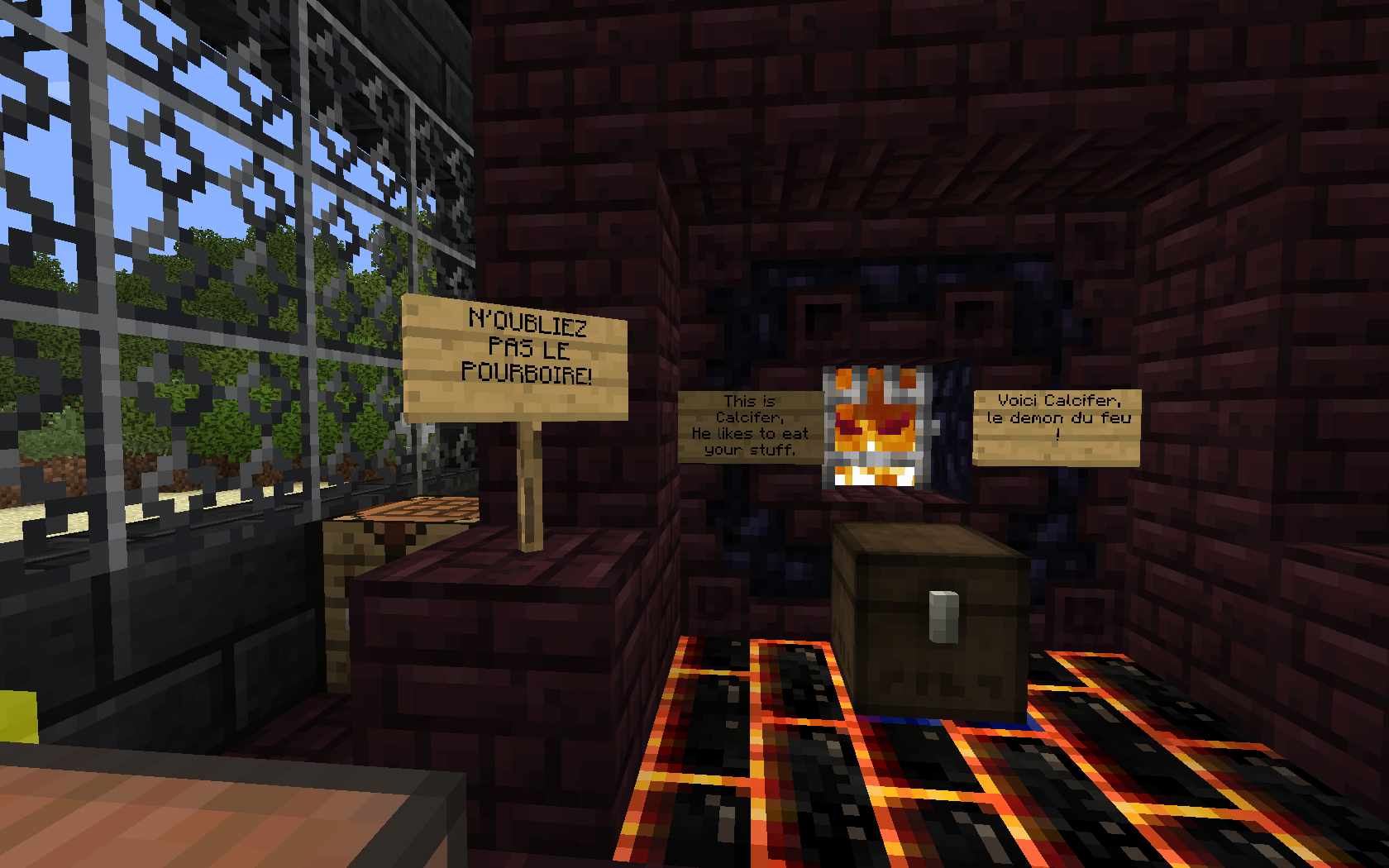
Calcifer, the fire demon held inside the infernal furnace, spits out cooked chicken and chicken nuggets at a leisurely pace. Thank you Thaumcraft or this would never have been possible.
Notes
- Other than the video game-specific rules inherent to Minecraft, the mLab server has socially-enforced rules, also called “local rules”, rules that players create within their own social groups, or by the server’s host. BFC’s interactions (as a project and as a digital structure) with some of these local rules was sometimes a bit rocky.
- It is interesting to see how players take to industrialization and automation. Some players shy away from it, perhaps because it makes the game too easy too fast (as if playing on “godmode”/creative mode). Other players spend all their time creating machines that never stop working. There are also ideological reasons against industrialization that have been carried over from the non-digital world.
- For more conclusive conclusions about the BFC and how it was built, you can also check out my slides here from a presentation on the topic last spring.
Bonus Section! Quotes from various mLab Players about BFC:
These quotes are from mLab players not attached to the project. I asked them if they would be willing to share a sentence (or more) on what they thought of the BFC on their server. These quotes are presented in no particular order, anonymously, and with some editing to preserve clarity. I thought it would be useful to catalogue these responses for posterity.
- I was personally disturbed by the ownership of the server that was displayed, and wanted nothing to do with the project.
- I think it’s an interesting idea. it fits with the spirit of factorization (making players’ life easier) on the server, however it never became part of the ecosystem. I think it’s partially because we [the server’s players] didn’t build it. Hired workforces built it and that didn’t blend organically with the “society” on the server. The group of people that play on the server are a liberal bunch who frown upon big corporations in real life and that translates to the game. This server is peculiar because we tried to take into account the NPC (non playable characters) and in that context, having a fast food restaurant mercilessly massacring chickens by the thousands is not something people will support.
- I saw it as literally nothing more than a slightly eyesoreish source of free murder-flavoured nutrition.
-
[On the subject of] the actual building and machine itself I don’t have much to say really. It’s kind of nice but also it’s really weird how it’s just an exact copy of an existing design. It ignores all the ways in which the mods on the server could make accomplishing the task easier or more interesting. What I thought was kind of weird was mainly these things: because the server was the site of this research project it raised some issues about where the ownership of the server rested and who was working for who, which only got more confusing as time went on as new people were hired and the server was taken out of the mLab, without the knowledge of the players or the original maintainer of the server. Because the server was moved to a new locked location, the server’s performance dropped, players stopped going online. Eventually the server was returned, but the entire ordeal seems illustrative of the way academia appropriates students’ work. [Because of all the issues with regards to the ownership of the server] I didn’t keep a super close eye on the project itself but it seems that undergrads were basically hired to build the fried chicken thing after a detailed blueprint [and] some of them hadn’t even played minecraft before? I’m not sure what the goal of the study was really, but I hope it wasn’t to study anything representative of typical minecraft play. You had people playing on the server not because they enjoy it but because it’s a job, and instructions can restrict the creative freedom that is kind of a big part of Minecraft. This is a super obvious example of alienation in the Marxist sense.
- I have only known the BFC as a ruin which makes it seem kind of legendary. I’ve been pillaging it for building supplies.
The post Big Fried Chicken Post-Mortem appeared first on &.
]]>The post The Hermeneutics of Code appeared first on &.
]]>
Co-authored Abstract for DiGRA 2015: William Robinson, Dylan Lederle-Ensign and Michael Mateas
Procedural Deformation and the Close Playing/Reading of Code:
An Analysis of Jason Rohrer’s Code in Passage
Despite Game Studies’ interest in digital games, the field has paid comparatively little attention to the algorithms underlying the medium. The following paper argues for the value of game code analysis and works towards potential methodologies. Platform studies has by necessity done some of this work in its appeals to analyzing game hardware and software along with the affordances and constraints they place on media (see Montfort and Bogost 2009; Salter and Murray 2014). That said, the interest here is not to generalize theories of platforms from snippets of code. Rather, this paper explores the meaning of code in the context of a game whose processes and mechanics are intended to be read metaphorically (Bogost 2009; Treanor and Mateas 2010). While software studies has previously focused on the abstracted operational logics of games (Wardrip-Fruin and Mateas 2009, Wardrip-Fruin 2009; Fox Harrell 2013), we focus on a detailed code-level analysis. Code-level readings of games do exist (Marino 2006, Sample 2011), but these have tended to focus on comments and variable names, rather than analyzing the relationship between the code-level expression of process and player interpretation. Drawing from works in software studies (Fuller 2008; Galloway and Thacker 2007; Bolter et al. 2013) and game studies, we argue that appeals to code may offer insights into the tensions between the practice of game development and the affordances and constraints of computational tools. We use code found in Jason Rohrer’s art-game Passage as a case study. Despite having been theorized by multiple game scholars (e.g. Bogost 2008; Parker 2012; Whalen 2012), Passage’s code has never been examined, nor has anyone considered the importance of its open-source nature. While its code is not representational in the same ways as its output, it does hold hermeneutic meaning that is detectable upon a procedurally literate inspection. What is more, as an artwork with underpinnings left intentionally accessible for public consumption, it is not unreasonable to consider it in this way.
Given the scope of this essay and that Passage has thousands of lines of code, only two portions of Rohrer’s work will be discussed here. The first relates to the hidden contents of in-game chests. The second is responsible for the game’s procedurally generated labyrinths. While both sections were selected because they are illustrative of Rohrer’s style of coding, each also illustrates a proposed methodology for game code studies: Close Reading/Playing Code and Procedural Deformation.
To illustrate our use of close reading/playing of code, we turn to Rohrer’s use of scoring in Passage. In his creator statement, Rohrer discusses the game’s metaphoric chests, suggesting that “not every pursuit leads to a reward—most of them are empty.” Rohrer continues the metaphor in explaining that these chests are marked with a sequence of gems and that “During your lifetime, you can learn to read these sequences and only spend your precious time opening worthwhile treasure chests.” From this we infer that in a single run of Passage (what Rohrer refers to as a lifetime) it should be possible to predict the outcomes of a chest’s contents, and that being able to do so will lead to a higher score. In this instance, Rohrer implies that worthwhile chests are valuable in the fiction of his game, a position echoed by their positive impact on the high score. Current writing on Passage has not addressed this puzzle, which we solved using a combination of code reading and close playing.
The following lines of code can be found in gamma256/gameSource/game.cpp, the core game file:
514 // the gem that marks chests containing points
515 int specialGem = time( NULL ) % 4;
These two lines set up an enormous amount of explanation and investigation to come. Setting aside for the moment an explanation of what the code means, let us continue following the places this number is used. Further down the same file, we find the code that executes when the player touches a closed chest. This is the only other place that specialGem appears in the code:
1183 if( getChestCode( (int)playerX, (int)playerY ) &
1184 0x01 << specialGem ) {
While this is the core of the chest puzzle, code reading alone was not enough to decipher a solution. These two snippets of code begin to give a sense of the futility of isolated code reading as a method for understanding the game elements they implement. These two lines leave us with questions whose answers are all in other parts of the code. Even so, the static definition does not provide a clear answer to the original question about the chest puzzle. While reading this code gave us a hint of the solution, specifically that there were five possible chest solutions randomly assigned to the level, we only fully understood the chest puzzle through a combination of close playing and theorycrafting. Building color coded tables of information about the contents of chests and their gems for each playthrough (as opposed to all playthroughs), we deployed one of the techniques used by powergamers, as described by Chris Paul in his work on theorycrafting (2012). Not only did we uncover the solution to Rohrer’s puzzle, but found our hermeneutic reading of the game had changed.
Our second methodology is also literary in nature. Lisa Samuels and Jerome McGann, in their essay Deformance and Interpretation draw from Emily Dickinson’s proposal to read poems backward. They explain, “Reading Backward is a critical move that invades these unvisited precincts of imaginative works. It is our paradigm model of any kind of deformative critical operation. Such a model brings to attention areas of the poetic and artifactual media that usually escapes our scrutiny” (36). Samuels and McGann admit that their approach may be seen as heretical, given the goal of hermeneutic reading is largely meant to avoid “against the grain” readings, but we demonstrate here that this process of deformation is productive in generating new perspectives and questions on poetic works. What is more, we argue that this method has an affinity for code studies, given the emergent nature of the medium.
To discuss our use of procedural deformation, we turn to a second metaphor in Passage: the contradictory goals of advancing forward along the X-axis and the pursuit of treasure chests which appear further along the Y-axis. Metaphorically, these goals potentially relate to any number of everyday trade-offs. Rohrer effectively represents the structural metaphor of these mutually exclusive choices by offering the player a compelling interactive spatial representation. He does this by procedurally generating a map which becomes denser with impassable terrain as one moves down along the Y-axis. This paper describes the map generation algorithm in the context of Passage’s overall design, and explores alternative parameters that significantly alter the play experience and game’s rhetoric. We made several alternate versions of Passage, with changes ranging from small changes to the weights of random numbers to larger changes that expand the field of view and expose the entire map clearly. While Rohrer characterizes the map as a maze, it only functions as such when the player has a limited view. Similarly, modifying the weights with which walls or chests are placed in the world can significantly alter the game’s hermeneutic readings. In an alternate version with denser chests, exploring to the right becomes significantly less appealing. These deformations allow us to interrogate the values and parameters that Rohrer chose, and lead to a deeper understanding of their rhetorical purpose.
These two approaches are of course only loosely sketched, and owe much to the work of digital humanists, such as Alan Liu’s analyses of markup language (2004) or Wendy Chun’s analysis of code as fetish (2008). That said, the practice of digging into complex game code and unpacking its interactions for aesthetic and political analysis is altogether unexplored, which is why we take the research risk here.
BIBLIOGRAPHY
Bizzocchi, J., et. al. “Games, narrative and the design of interface.” International Journal
of Arts and Technology 4.4 (2011): 460-479.
Bolter, J., et al. “Liveness, Presence, and Performance in Contemporary Digital
Media.” Throughout: Art and Culture Emerging with Ubiquitous Computing (2013): 323.
Bogost, I. “Fine processing.” Persuasive Technology. Springer Berlin Heidelberg, 2008.
13-22.
Bogost, I. Persuasive games: The expressive power of videogames. Mit Press, 2007.
Burden, M, and S. Gouglas. “The Algorithmic Experience: Portal as Art.” Game
Studies 12.2 (2012).
Carroll, N. “Hume’s Standard of Taste.” The Journal of Aesthetics and Art Criticism /
American Society for Aesthetics. Ed. Thomas Munro. (1985): 181-194. Print.
— 4 —
Chun, W. “On “sourcery,” or code as fetish.” Configurations16.3 (2008):
299-324.
Fuller, M. Software Studies: A Lexicon. Cambridge, Mass: MIT Press, 2008.
Galloway, Alexander R., and Eugene Thacker. The exploit: A theory of networks. Vol. 21.
U of Minnesota Press, 2007.
Harrell, D. Phantasmal Media: An Approach to Imagination, Computation, and
Expression. MIT Press, 2013.
Knuth, D. Literate Programming. Stanford, CA: Center for the Study of Language and
Information, Stanford University Press, 1992.
Livingston, P. “Poincaré’s” Delicate Sieve”: On Creativity and Constraints in the
Arts.” (2009).
Liu, A. “Transcendental Data: Toward A Cultural History and Aesthetics of the New
Encoded Discourse.” Critical Inquiry 31 (2004): 49-84.
Liu, A. “Where is Cultural Criticism in the Digital Humanities.” Debates in the Digital
Humanities. Minneapolis: University of Minnesota Press. 2012.
Manovich, L. Software takes command. Vol. 5. A&C Black, 2013.
Marino, M. “Critical code studies.” Electronic book review 4 (2006).
Mateas, M., and N. Wardrip-Fruin. “Defining operational logics.” Digital Games
Research Association (DiGRA) (2009).
McGann, J., and Lisa S. “Deformance and interpretation.” New Literary History 30.1
(1999): 25-56.
Montfort, N., and I. Bogost. Racing the Beam: The Atari Video Computer System.
Cambridge, Mass: MIT Press, 2009. Internet resource.
Möring, S. “Tackling the metaphor-simulation dilemma.” Proceedings of DiGRA Nordic
2012 Conference: Local and Global—Games in Culture and Society. Available from http://www. digra. org/dl/db/12168.04280. pdf. 2012.
Parker, F. “An Art World for Artgames.” Loading… 7.11 (2012).
Paul, C. “Optimizing play: How theorycraft changes gameplay and
design.” Game Studies 11.2 (2011).
Rohrer, J. 2007. “What I Was Trying to Do with Passage”
http://hcsoftware.sourceforge.net/passage/statement.html
Salter, A., and J. Murray. Flash: Building the Interactive Web. MIT Press, 2014.
Sample, M. “A Revisionist History of JFK Reloaded.” Jun. 7, 2011. Accessed: Jan. 19
2015.
Sharp, J. “A curiously short history of game art.” Proceedings of the International
Conference on the Foundations of Digital Games. ACM, 2012.
Sicart, M. “Against procedurality.” Game studies 11.3 (2011).
Skolnik, M.R. (2013) “Strong and Weak Procedurality.” Journal of Gaming and Virtual
Worlds. Vol. 5, Iss. 2. 2013. pp. 147-163
Treanor, M., and M. Mateas. “An Account of Proceduralist Meaning.” (2011).
Treanor, M., M. Mateas, and N. Wardrip-Fruin. “Kaboom! is a Many-Splendored Thing: An interpretation and design methodology for message-driven games using
graphical logics.” Proceedings of the Fifth International Conference on the Foundations of Digital Games. ACM, 2010.
Wardrip-Fruin, N. Expressive Processing: Digital fictions, computer games, and software
studies. MIT press, 2009.
Whalen, Z. “Using Passage to Think About Cultural Privilege.” Nov. 27 2012. Accessed:
Jan. 19 2015.
The post The Hermeneutics of Code appeared first on &.
]]>The post A Squirrel Is Stuck Between An Ocean And A Hard Place appeared first on &.
]]>Approaches to AI in virtual systems and Minecraft
Yesterday, while wandering around the mLab and procrastinating between deciding to go to bed at a reasonable hour or stay up and work on midterms, I came across something I have seen many times in my Minecraft play. A small non-agressive mob was stuck between the ocean and a ledge on a cliff, with no means of escape. By small, I mean a mob that is smaller than half of a game “block” (Minecraft’s “standard” unity of measurement) and in this particular case the mob was a squirrel, a colourful addition to Minecraft’s bestiary from one of the mLab’s 130 odd mods. Either it spawned on the ledge or had fallen there, and because of its small size, it was stuck on the ledge, doomed to fall into the ocean if it tried to escape.
Thus the squirrel simply sat there.
In meatspace, or the real world, the squirrel would die of starvation if the squirrel had found itself on that ledge. Perhaps the meatspace squirrel would be motivated by some instinct to attempt to climb the impossibly steep dirt and rock cliff facade.
But in Minecraft, the squirrel is doomed to its fate until the system despawns the chunk of server land that this drama is unfolding upon. The squirrel is doomed to sit there on that ledge, ostensibly for as long as the server chunk is loaded, for the rest of time.
Because I wasn’t thinking of taking screenshots of the stranded Minecraft squirrel last night (sleep deprivation, tsk tsk) I decided to illustrate the situation for you with a sketch:
The squirrel is in a tough situation. As I was fluttering about the server, and I saw this squirrel, my immediate impulse was to dig a little path into the cliff’s rocky face, so that the squirrel could escape to the woods above and go about its squirrelly business.
Why would I do that? Why so much empathy for a Minecraft squirrel?
The squirrel, after all, is just an artefact of computer code meant to do things that I, as a human playing Minecraft, can interpret as squirrel activity. This, and its aesthetic, cue my brain into seeing a “squirrel” as the manifestation of a bit of computer code. Without my interpretation and visual interaction with the squirrel, is that bit of computer code really a squirrel, or just a bit of computer code? If no one is around to interpret the squirrel’s immobile waiting on that rock ledge as panic and despair, is the squirrel really in any danger?
From the perspective of the strip of code governing the squirrel’s activity, that squirrel’s activity makes perfect sense. The computer code has judged the situation and asserted: “There is danger in every direction, but right here is safe. So the squirrel object won’t move. Success!”
It is my interpretation that the squirrel is stuck, and because I think a squirrel should be frolicking about in the woods, I have this idea that the squirrel’s activity sitting on a ledge is somehow unsatisfactory. I am moved to change the circumstances and give the squirrel an opportunity to rectify its activity.
In an interview between filmmaker Gina Harazsti and Dr Darren Wershler (I was lucky enough to see a preview of the footage last week) professor Wershler asserts that the reason we care so much about “cute mobs” in Minecraft is because of nostalgia. We don’t care about skeletons or creepers stuck on ledges with nowhere to go. We are nostalgic about squirrels in Minecraft because we are nostalgic about real squirrels. Is it that we want to play out a fantasy as a human emissary to an animal society in danger? There’s a lot of writing on “cuteness” and its evolutionary function. Are we playing out real-world biases via nonhuman mobs in Minecraft – because the squirrel has a fluffy tail and is so small, are we confusing two very different nonhuman “creatures” – one of flesh and fur, the other an artefact of software.

SO CUTE AND FLUFFFEEEEEEEEEE
When artificial intelligence research and cognitive science were both in their infancy, a piecemeal approach was developed by some researchers who were hoping investigations of artificial intelligence would be a useful tool to reproduce “human” intelligence. In his report Intelligence without representation by Rodney A. Brooks, where Brooks describes research done at the Artificial Intelligence Laboratory of the Massachusetts Institute of Technology, the paper asserts flat out: “Artificial intelligence started as a field whose goal was to replicate human level intelligence in a machine.” This original goal was gargantuan – but there was hope that in isolating the different “pieces” or components of cognition, we could replicate them with mechanical processes whose “brains” would be software. Brooks’ report was published in 1987 and as such presents a particular picture in time for artificial intelligence research – however I have found it interesting to compare some of the points he makes on the breakdown of artificial intelligence into units performing various functions, to the nonhumans of Minecraft.
I examined the points Brooks makes about artificial intelligence research concerned with making robots in the real world, rather than making software interacting in a virtual space. He mentions game spaces with the famous “blocks world” example :
In the late sixties and early seventies the blocks world became a popular domain for AI research. It had a uniform and simple semantics. The key to success was to represent the state of the world completely and explicitly. Search techniques could then be used for planning within this well-understood world. Learning could also be done within the blocks world; there were only a few simple concepts worth learning and they could be captured by enumerating the set of subexpressions which must be contained in any formal description of a world including an instance of the concept.
Brooks however criticizes the heuristic problem solving methodologies used in the “blocks world”, stating they are too simple for serious, epistemological artificial intelligence research. It is perhaps difficult to conceptualize what the “blocks world” was, as it was for me when I first started investigating it, and I stumbled upon SHRDLU – an early natural language understanding computer program. It is basically a programming software that learns to make “blocks” of concepts containing subexpressions. For instance, in a “blocks world” software, you could teach the software that chicken is a type of meat, and that meat is a concept “block” worth remembering for further interactions. An example from SHRDLU illustrates this:
Person: PICK UP A BIG RED BLOCK.
Computer: OK. (does it)
Person: GRASP THE PYRAMID.
Computer: I DON'T UNDERSTAND WHICH PYRAMID YOU MEAN.
Person: FIND A BLOCK WHICH IS TALLER THAN THE ONE YOU ARE HOLDING AND PUT IT INTO THE BOX.
Computer: BY "IT", I ASSUME YOU MEAN THE BLOCK WHICH IS TALLER THAN THE ONE I AM HOLDING.
Computer: OK. (does it)Person: WHAT DOES THE BOX CONTAIN?
Computer: THE BLUE PYRAMID AND THE BLUE BLOCK.
Person: WHAT IS THE PYRAMID SUPPORTED BY?
Computer: THE BOX.
Person: HOW MANY BLOCKS ARE NOT IN THE BOX?
Computer: FOUR OF THEM.
Person: IS AT LEAST ONE OF THEM NARROWER THAN THE ONE WHICH I TOLD YOU TO PICK UP?
Computer: YES, THE RED CUBE.
Person: IS IT SUPPORTED?
Computer: YES, BY THE TABLE.
Person: CAN THE TABLE PICK UP BLOCKS?
Computer: NO.
Person: CAN A PYRAMID BE SUPPORTED BY A BLOCK?
Computer: YES.
Person: CAN A PYRAMID SUPPORT A PYRAMID?
Computer: I DON'T KNOW.
Person: STACK UP TWO PYRAMIDS.
Computer: I CAN'T.
Person: WILL YOU PLEASE STACK UP BOTH OF THE RED BLOCKS AND EITHER A GREEN CUBE OR A PYRAMID?
Computer: OK. (does it)
Person: WHICH CUBE IS SITTING ON THE TABLE?
Computer: THE LARGE GREEN ONE WHICH SUPPORTS THE RED PYRAMID.
Person: IS THERE A LARGE BLOCK BEHIND A PYRAMID?
Computer: YES, THREE OF THEM: A LARGE RED ONE, A LARGE GREEN CUBE, AND THE BLUE ONE.
Person: PUT A SMALL ONE ONTO THE GREEN CUBE WHICH SUPPORTS A PYRAMID.
Computer: OK. (does it)
Person: PUT THE LITTLEST PYRAMID ON TOP OF IT.
Computer: OK. (does it)
Person: DOES THE SHORTEST THING THE TALLEST PYRAMID'S SUPPORT SUPPORTS SUPPORT ANYTHING GREEN?
Computer: YES, THE GREEN PYRAMID.
Is the computer software actually learning something? It certainly simulates the process of learning. It knows that it can 1) do an action 2) admit the action is impossible, or that it can 3) answer a question in the affirmative or 4) answer a question in the negative or state 5) admit ignorance. But if you taught the computer thousands of different concepts (cubes, pyramids, pasta, cookies, ducks, stellar cartography) broken down into “blocks” of “knowledge” represented by “strings” – would the computer software actually be able to execute commands other than the 5 outputs available above? The simplifications of the world and the types of input-output available are too far removed from real-world abstractions and complexities to hold any weight.
I return to my Minecraft squirrel drama on the ledge. The squirrel program running inside Minecraft could be having a similar conversation to the one archived by SHRDLU :
Squirrel: I am sitting here.
Computer: You are indeed sitting here.
Squirrel: Should I move forward?
Computer: You should not. There is a vast ocean and you will drown.
Squirrel: Should I move left?
Computer: You should not. There is an ocean there too.
Squirrel: That sucks. Maybe I should move right?
Computer: Nope. Ocean all around, amigo.
Squirrel: Awww man. Shall I move backwards?
Computer: There is a block of earth there.
Squirrel: What about jumping? Can I jump onto the block of earth?
Computer: Alas, you can’t. There is a block of earth there too.
Squirrel: So… I should just sit here?
Computer: Sounds good to me.
The squirrel, like the SHRDLU program, takes “input” from the world (in this case, the computer is controlling what is in the world, but in the SHRDLU program, the world seems largely defined by the human-defined input.) The squirrel program is totally cool just sitting there, because it has gone through its programming and figured out that in order to stay alive (which squirrels in Minecraft apparently like to do) it should stay out of the water. The squirrel will never learn to dig through the earth or climb against the facade to get out. The program is quite content to execute its programming and chill.
So when I feel pangs of sadness that a squirrel is caught on the ledge, that is my human abstraction of what is going on. The squirrel program is actually quite happy where it is. But wouldn’t the squirrel also be quite happy to move around, too? When I’ve watched Minecraft mob patterns, I’ve noticed that almost all creatures feel an impulse to move around. If I unleash a pack of chickens into the wild, they’ll meander away eventually, often splitting off into different directions. Squirrels are similar, bounding away happily in the world. I have dug into the process of “artificial intelligence” in the mobs of Minecraft, I still feel the need to wonder – would the squirrel prefer to be moving, and does it consider that state ideal? I project the human emotion “happiness” onto the bounding squirrels and chickens of Minecraft – but could that be a fanciful description of something actually happening within the hardware.
While I know that aesthetically, I am sympathizing with the squirrels and chickens of Minecraft because they are kind of cute, I also have to wonder if from an artificial intelligence point of view, something deeper may be occurring under the surface. Of course, I can terminate the Minecraft program and walk away from the stranded squirrel completely. Brooks argues that “toys” offer too simplified a domain for serious study, and it is perhaps anachronistically futile to use an AI research paper from 1987 to contemplate upon Minecraft, a game released in 2009.
I am intrigued, reading Brooks, when he lists the engineering methodology behind building Creatures: “completely autonomous mobile agents that co-exist in the world with humans, and are seen by those humans as intelligent beings in their own right.” These artificial organisms would exhibit the following properties:
- Timeliness (as in reaction time)
- Robustness (minor changes in the properties of the world will not lead to a total collapse of the Creature’s activity or behaviour)
- Goals (the Creature should be able to maintain multiple goals, and, depending on the situation, prioritize one goal over another, as well as take advantage of fortuitous opportunities)
- Purpose (a Creature should do something in the world, should have some purpose in being)
In many ways, the Minecraft mobs satisfy these four requirements. The squirrel prioritizes staying alive over bounding about happily, the squirrel would jump up and try to flee if I hit it with my battleaxe, the squirrel reacts if I dig a path in the earth for it to escape the cliff and the squirrel has a purpose : it is a denizen of the forest, and makes the forest complete.
However, where Brooks and I may differ on interpretation of the concept of a Creature is in the words “co-exist in the world with humans” – players may enter the world of Minecraft, but are they really “in” the world of Minecraft? As pieces of software, does the squirrel program really “exist in the world” – is its physical existence as a tiny component of a hardrive a big detractor from its software, virtual manifestation?
The squirrel of Minecraft is an artefact running on the software foundations of a lot of artificial intelligence research. We can pause or “disable” the squirrel program, or the SHRDLU program, and when we re-engage the program it does not restart from scratch necessarily – depending on how Minecraft decides how mobs are loaded and respawned into chunks, that same squirrel may reappear, and reassess that it is still stuck between the ocean and a hard place. But is it really the same squirrel? Is it really manifesting a portion of intelligence? Would it prefer to be bouncing about happily rather than stuck on the ledge?
Or is this all besides the point – is the more interesting investigation with regards to how the player responds to the situation. So I ask you the question: if you found the squirrel stranded on the ledge, would you do anything about it? And why?
The post A Squirrel Is Stuck Between An Ocean And A Hard Place appeared first on &.
]]>The post Building Online Community Despite The Gamers appeared first on &.
]]>This week, instead of a weeknote focused on #BigFriedChickenCompany and the work my comrades Marie Christine, Sean and Saeed have been contributing to, I’d like to devote some thought to a greater picture with regards to Minecraft.
Minecraft is somewhat singular. It’s a computer program which can be run individually by one person, or on a server as a space that can be shared by a myriad of different communities. “Minecraft the Phenomenon” is the runaway success of a lone 30 something high school drop-out programmer nicknamed Notch. The indie developer’s dream is to build another Minecraft – where the programming can be shoddy, the execution hit or miss, but the community rock solid. Multiplayer games are very fashionable lately, but whether one is part of the big bucks AAA industry or the indies starving in the garage community, everybody wants what Minecraft has: the sheer volume of people who love Minecraft, mod Minecraft, and build on Minecraft.
Microsoft this month put a price tag on the Minecraft Phenomenon – 2.5 billion dollars US.
Minecraft to join Microsoft http://t.co/ebAuoNC7mO pic.twitter.com/LePrYjCysC
— Microsoft (@Microsoft) September 15, 2014
This week, I’d hoped to write a little more on the communities of Minecraft I’ve experienced, but my attention was pulled away from this topic by the real world. I’ll be touching on my own experiences, but within a much larger context than my experiences either on the TAG minecraft server from last spring, or on the mLab server in which the #BigFriedChickenCompany is now being built anew.
A few weeks ago, I caught wind on twitter of a then-unconfirmed rumour that Mojang, the studio behind Minecraft, was being purchased by Microsoft. While the ideology behind the purchase did not really perturb me (“oh noes! my favourite billion-dollar indie videogame is going to become billion-dollar corporate sludge!”) I was intrigued to hear about what was going on with Minecraft’s renowned creator Notch.
The reaction on twitter against Notch was, at first, overwhelmingly negative while a certain core of gamers complained that Notch was “selling out.” Major news outlets even picked up on some of the negativity circulated by fans of the game. Notch wrote a blog post about his exit strategy – the blog post, written in the form of a letter to the Minecraft fans, reads like the writing of someone on the edge of burnout and emotional collapse. Notch writes that he doesn’t have the connection with the fans that he thought he did, he can no longer accept the mental and emotional strain of heading Minecraft (the program, the community and the phenomenon now indistinguishable) any longer.
The reason I’m focusing so much on Notch’s goodbye letter is because of the following paragraph:
I was at home with a bad cold a couple of weeks ago when the internet exploded with hate against me over some kind of EULA situation that I had nothing to do with. I was confused. I didn’t understand. I tweeted this in frustration. Later on, I watched the This is Phil Fish video on YouTube and started to realize I didn’t have the connection to my fans I thought I had. I’ve become a symbol. I don’t want to be a symbol, responsible for something huge that I don’t understand, that I don’t want to work on, that keeps coming back to me. I’m not an entrepreneur. I’m not a CEO. I’m a nerdy computer programmer who likes to have opinions on Twitter.
If you haven’t seen that Phil Fish documentary, please do. To talk about Phil Fish has nothing to do with Phil Fish but everything to do with fame, audience, the internet, and indie videogames.
It dawned on me then, that Notch leaving games is an event that cannot be unpacked without also addressing the extremely broken state of videogames (the programs, the community, the industry). The community, hobbled around an identity generated by corporations and viciously attacking those that don’t belong, is rabid. This concept of a removed, anonymous, money-throwing glob called “audience”, in the age of independent video game developers sharing on Twitter and the internet, is revealed to be a toxic place. Traditionally, the storyteller sitting around a campfire used the rhythms and whims of the audience to the story’s advantage. Where videogames are concerned, and game makers and story tellers are separated by a thin veneer of… something … the discontented audience glob continues to act like a pack of rabid dogs.
Of course, I’m talking about #GamerGate. (To bring you up to speed, I do believe the best article on the subject so far is this article on Cracked. Yes, the listicles of clickbait website.)
The sheer vitriol thrown at Anita Sarkeesian and Zoe Quinn in the past year by the amorphous glob known on Twitter as #GamerGate is terrifying. Offline and online, people are rallying together and asking themselves what on earth is going on. I’ve attended formal meetings at my university with fellow game makers, writers and researchers wondering what can be done to make video games a better place. Women especially are worried of having their real names on their projects. People are attacked online constantly, but there’s a concentration of inane, repetitive cruelty in the GamerGlob that’s making women question their decision to work in video games. Many have left in the past few months. Even Notch, a freshly-minted billionaire and infinitely more privileged than most targets of harassment and ire, writes that he afraid of losing his sanity over Minecraft and its relationship with the amorphous “audience” glob.
There is something wrong with the community that Microsoft just paid 2.5 billion dollars for. When I first began playing Minecraft for university, I was enchanted by the nature of the online community which was so different from my experiences playing Guild Wars and World of Warcraft. Six months later, the honeymoon’s over, I’ve seen the good, the worst and the ugly. I’ve seen communities built on Minecraft and wane on Minecraft, reflecting real world and in game rhythms. I’m still reflecting about what it means to build a community of modders and builders – as well as thoughtful gamers. That community cannot be built, on the TAG or mLab Minecraft servers or anywhere else, without a good hard look at the larger contexts in which these communal spaces exist.
Update
A really amazing game developer who on twitter goes by @mcclure111 astutely observes that this post outlines a problem but really doesn’t offer anything concrete as a solution.
I offer this post as a piece of the process of recognizing how deeply felt the warping of “audience” and “creator” is, how far removed videogames are from “story” and “storyteller” (was there ever a link at all?) and how poisoned the “gamer” identity is/always was. I am still reflecting on a solution. I hope you will too.
Further Reading
Carolyn Jong at TAG has compiled a very good list of resources here.
The post Building Online Community Despite The Gamers appeared first on &.
]]>